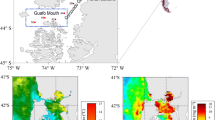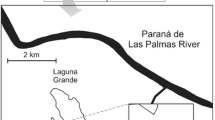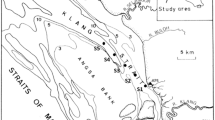Abstract
About 40% of all fish species occur in freshwater, although only 1% of the globe is occupied by freshwaters. The tropics harbour a high percentage of these fishes. Freshwater zooplankton on the other hand is far less diverse than its marine counterpart and the tropics do not harbour a markedly high percentage of freshwater species either. The antecedents of freshwater zooplankton appear to have come from riverine and terrestrial habitats via temporary habitats (ponds, floodplains). The present zooplankton composition has also been shaped by, among other factors, the highly efficient zooplanktivorous modern teleosts which have restricted the formerly widespread Branchiopoda mainly to fishless freshwaters. Those Branchiopoda frequently co-existing with fishes (Cladocera) have their size composition strongly influenced by fish predation. Circumstantial evidence indicates that pelagic zooplankton (Cladocera, Copepoda, Rotifera) appear to provide a relatively scarce food supply relative to the littoral region for the early stages of fishes. Also, unpredictability of zooplankton may be involved here. These factors have led to the loss of planktonic eggs and the siting of fish breeding in shallow littoral situations, where other animal foods besides zooplankton are also available, especially for later stages of juvenile fish. The Ostariophysi breed in the shallow expanses of flood waters while the Cichlidae, some of which breed like Ostariophysi, also breed in standing waters in the littoral of lakes or floodplains. In all these locations zooplankton and benthic organisms, especially insects, are available. The cichlids are, in addition, provided with parental care. Predation on young fishes is also reduced by these strategies. Young fishes may also be adapted to feed on patches of zooplankton and other food in their breeding grounds. Tropical pelagic clupeids and cyprinids may breed continuously. Some of these clupeids in rivers breed at low water.
Zooplankton, supplemented by other animal food is more critical to achieving the potential fish yields in the tropics than in temperate freshwaters because fish yields in the tropics can be very high indeed. The high metabolic rate of young fishes in the tropics adds to the demand for food. Tropical freshwaters have a relatively high primary production but a low zooplankton/phytoplankton ratio. Zooplankton is kept small in size and biomass by continuous predation. Herbivorous fishes can sustain very high fish yields in the tropics but they must have a high fecundity and high survival of young produced seasonally, mainly in rivers or even continuously as in lakes and reservoirs to weather predation. Rich littoral zooplankton and benthos combined with omnivory and a higher efficiency in the use of the available animal food by newly hatched fishes may be critical factors linking fish yields to zooplankton in tropical freshwaters. The ability of herbivorous tilapias to give very high fish yields in shallow tropical lakes may also be due to their efficient use of animal food, algae and microphagy in young stages besides other favourable adaptations like opportunistic feeding on detrities and the ability to feed on and digest cyanobacteria, abundant in the tropics.
Similar content being viewed by others
References
Arcifa, M. S., 1984. Zooplankton composition in 10 reservoirs in Southern Brazil. Hydrobiologia 113: 137–145.
Alikunhi, K. H., 1957. Fish culture in India. Ind. Counc. Agric. Res. New Delhi, Farm. Bull. 20: 1–144.
Balogun, J. K., 1986. Fish distribution in Kainji lake, Nigeria. J. Fish Biol. 29: 489–499.
Barbosa, P. M. M. & T. Matsumura-Tundisi, 1984. Consumption of zooplanktonic organisms by Astanyx fasciatus Cuvier, 1819 (Osteichthyes, Characidae) in Lobo (Broa) reservoir, Săo Paulo, S. P. Brazil. Hydrobiologia 113: 171–181.
Brandlovà, J., Z. Brandl & C. H. Fernando, 1972. The Cladocera of Ontario with remarks on some species and distribution. Can. J. Zool. 50: 1373–1403.
Briggs, I. C., 1980. Family Clupeidae. Herrings. In R. M. McDowell (ed.), Freshwater fishes of South-Eastern Australia. Reed, Sydney: 48–50.
Brooks, J. L. & S. I. Dodson, 1965. Predation, body size and the composition of plankton. Science 150: 26–35.
Carpenter, S. R., 1988. Complex interactions in lake communities. Springer-Verlag, New York, 283 pp.
Chapman, G. C., 1991. The diet and feeding habits of Oreochromis niloticus (Linnaeus) and Cyprinus carpio (Linnaeus) in lowland rice fields in Northern Thailand. M. Sc. Thesis, University of Waterloo, 131 pp.
Coulter, G. W., 1991. Pelagic fish. In G. W. Coulter (ed.), Lake Tanganyika and its life, Oxford University Press, London: 111–138.
Davis, C. C., 1959a. Should we love or hate Cyclops. The Aquarium 28: 200–203.
Davis, C. C., 1959b. Damage to fish fry by cyclopoid copepods. Ohio J. Sci. 59: 101–102.
Doge, D. P. (ed.), 1990. International large river symposium (LARS). Can. Spec. Publ. Fish. aquat. Sci. 106: 1–629.
Dominey, W. J., 1984. Effects of sexual selection and life history on speciation. Species flocks in African cichlids and Hawaiian Drosophila. In A. A. Echelle & I. Kornfield(ed.), Evolution of fish species flocks. Univ. Maine Press, Orono: 231–249.
Dumont, J. J., 1986. The Tanganyika sardine in Lake Kivu: Another ecodisaster for Africa. Envir. Conserv. 13: 143–148.
Duncan, A., 1984. Assessment of factors influencing the composition, body size and turnover rate of zooplankton in Parakrama Samudra, an irrigation reservoir in Sri Lanka. Hydrobiologia 113: 201–215.
Fabian, M. W., 1960. Mortality of freshwater and tropical fish by cyclopoid copepods. Ohio. J. Sci. 60: 268–270.
Fernando, C. H., 1965. A preliminary survey of 21 Ceylon lakes 3. Parasites and predators, food of fish and marginal fauna. Bull. Fish. Res. Stn. Ceylon 18: 17–27.
Fernando, C. H., 1980a. The freshwater zooplankton of Sri Lanka, with a discussion of tropical freshwater zooplankton composition. Int. Revue ges. Hydrobiol. 65: 85–125.
Fernando, C. H., 1980b. The species and size composition of tropical freshwater zooplankton with special reference to the Oriental Region (South East Asia). Int. Revue ges. Hydrobiol. 65: 411–426.
Fernando, C. H., 1983. Zooplankton and fish production, with special reference to the tilapias. In L. Fishelson & Z. Yaron (ed.), Proc. Int. Symp. Tilapia in aquaculture, Tel Aviv: 95–104.
Fernando, C. H. & J. Holčik, 1982. The nature of fish communities: A factor influencing the fishery potential and yields of tropical lakes and reservoirs. Hydrobiologia 97: 127–140.
Fernando, C. H. & J. Holčik, 1989. Origin, composition, and yield of fish in reservoirs. Arch. Hydrobiol. Beih. Ergebn. Limnol. 33: 637–641.
Fernando, C. H. & J. Holčik, 1990. Some impacts of fish introductions into tropical freshwaters. In P. S. Ramakrishnan (ed.), Ecology of biological invasion in the tropics. International Scientific Publications, New Delhi: 103–130.
Fernando, C. H. & J. Holčik, 1991. Fish in reservoirs. Int. Rev. ges. Hydrobiol. 76: 149–167.
Fernando, C. H. & C. Paggi & R. Rajapaksa, 1987. Daphnia in tropical lowlands. Mem. Ist. ital. Idrobiol. 45: 107–141.
Fernando, C. H., Seyoum Mengestou & Semeneh Belay, 1990a. The chydorid crustacean Alona diaphana (King) limnetic in Lake Awasa and Zwai, Ethiopia, with a discussion of littoral and limnetic zooplankton. Int. Revue ges. Hydrobiol. 75: 15–25.
Fernando, C. H., C. Tudorancea & Seyoum Mengestou, 1990b. Invertebrate zooplankton predator composition and diversity in tropic lentic waters. Hydrobiologia 198: 13–31.
Frey, D. G., 1990. What is a lake? Verh. int. Ver. Limnol. 24: 1–5.
Fryer, G. & T. D. Iles, 1972. The cichlid fishes on the Great Lakes of Africa. Oliver and Boyd, Edinburgh, 641 pp.
Gophen, M. & S. Serruya, 1990. Fish predation effects on plankton community structure in large lakes: Lake Kinneret. In M. M. Tilzer & C. Serruya (ed.), Large lakes: Ecological structure and function. Springer Verlag, New York: 645–660.
Gosline, W. A., 1971. Functional morphology and classification of teleostean fishes. Univ. Press of Hawaii, Honolulu, 208 pp.
Green, J., 1967. The distribution and variation of Daphnia lumholtzi (Crustacea: Cladocera), in relation to fish predation in Lake Albert, East Africa. J. Zool. Soc. Lond. 51: 181–197.
Green, J., 1985. Horizontal variations in associations of zooplankton in Lake Kariba. J. Zool. Lond. 206: 225–239.
Gross, M. R., R. M. Coleman & R. M. McDowell, 1988. Aquatic productivity and the evolution of diadromous fish migration. Science 239: 1291–1293.
Gurgel, J. J. S. & A. G. de Oliviera, 1987. Efetios da intraducăo peixas e crustăceas no semi-arrido do Nordeste Brasileiro. Collecăo Mossoroense (B) No. 453: 6–33.
Hamilton, S. K., S. S. Sippel, W. M. Lewis & J. F. Saunders, 1990. Zooplankton abundance and evidence for its reduction by macrophyte mats in two Orinoco floodplain lakes. J. Plankton Res. 12: 343–363.
Hartig, J. H., D. J. Jude & M. S. Evans, 1982. Cyclopoid predation on Lake Michigan fish larvae. Can. J. Fish. aquat. Sci. 39: 1563–1568.
Hecky, R. E., 1991. The pelagic ecosystem. In G. W. Coulter (ed.), Lake Tanganyika and its life. Oxford University Press, Oxford: 90–110.
Herdendorf, C., 1990. Distribution of the world's large lakes. In M. M. Tilzer & C. Serruya (ed.), Large lakes: Ecological structure and function, Springer Verlag, New York: 3–38.
Hickley, P. & R. G. Bailey, 1987. Food and feeding relationships of fish in the Sudd Swamps (River Nile, Southern Sudan). J. Fish. Biol. 30: 147–160.
Hickling, C. F., 1961. Tropical inland fisheries. Longmans, London, 287 pp.
Hopson, A. J. & A. J. D. Ferguson, 1982. The food of zooplanktivorous fishes. In A. J. Hopson (ed.), Lake Turkana. Overseas Development Administration Publications, London, 1505–1523.
Houde, E. D., 1975. Effects of stocking density and food density on survival, growth and yield of laboratory reared larvae of sea bream, Archosargus rhomboides (Sparidae). J. Fish. Biol. 7: 115–127.
Hrbàček, J., 1977. Competition and predation in relation to species composition of freshwater zooplankton, mainly Cladocera. In J. Cairns (ed.), Aquatic microbial communities. Garland, New York: 307–353.
Hrbàček, J., M. Dvořáková, V. Kořínek & L. Procházková, 1961. Demonstration of the effects of the fish stock on the species composition of zooplankton and the intensity of metabolism of the whole plankton association. Verh. int. Ver. Limnol. 14: 192–195.
Hurlbert, S. H. & M. S. Mulla, 1981. Impacts of mosquitofish (Gambusia affinis) predation on plankton communities. Hydrobiologia 83: 125–151.
Hyslop, E. J., 1986. The food habits of four small-sized species of Mormyridae from the floodplain pools of the Sokoto-Rema River Basin. J. Fish. Biol. 28: 147–151.
Iongh, H. H., P. C. Spleithoff & V. G. Frank, 1983. Feeding habits of the clupeid Limnothrissa miodon (Boulenger), in Lake Kivu. Hydrobiologia 102: 113–122.
Jenkins, R. M., 1979. Predator-prey relations in reservoirs. In R. H. Stroud & M. Clepper (ed.), Predator-prey systems in fish communities and their role in fisheries management. Sport Fisheries Institute Washington D.C. 123–134.
Jhingran, V. G., 1982. Fish and fisheries of India. Hindustan press, New Delhi, 666 pp.
Johannes, R. E., 1978. Reproductive strategies of coastal marine fishes in the tropics. Envir. Biol. Fishes 3: 141–160.
Junk, W., P. B. Bayley & R. E. Sparks, 1990. The food pulse concept in river-floodplain systems. In D. P. Dodge (ed.), International Large River Symposium (LARS). Can. Spec. Publ. Fish. aquat. Sci. 106: 111–127.
Kerfoot, W. C. & M. Lynch, 1987. Branchiopod communities: Association with planktivorous fish in space and time. In W. C. Kerfoot & A. Sih (ed.), Predation: Direct and indirect impacts on aquatic communities. The University Press of New England, Hanover, (NH): 367–378.
Lakshmanan, M. A. V., 1969. On carp fry mortality due to cyclops attack. J. Bombay Nat. Hist. Soc. 66: 391–392.
Lane, R. C., 1948. The world's great lakes. Doubleday, New York, 254 pp.
Lazzaro, X., 1987. A review of planktivorous fishes, their evolution, feeding behaviours, selectivities and impacts. Hydrobiologia 146: 97–167.
Lazzaro, X., 1992. pers. com.
Lehman, J. T., 1988. Ecological principles affecting community structure and secondary production in marine and freshwater environments. Limnol. Oceanogr. 39: 931–945.
Lowe-McConnell, R. H., 1975. Fish communities in tropical freshwaters. Longman, London, 337 pp.
Lowe-McConnell, R. H., 1987. Ecological studies in tropical fish communities. Cambridge University Press, Cambridge, 382 pp.
Lundberg, J. G., W. M. Lewis, J. F. Saunders & F. MagoLeccia, 1987. A major food web component in the Orinoco river channel: Evidence from planktivorous electric fishes. Science 237: 81–83.
Marshall, B. E., 1984. Small pelagic fishes and fisheries in African inland waters. FAO, CIFA Tech. Pap. No. 14: 25 pp.
Matěna, J. 1992. pers. com.
Mavuti, K. M., 1990. Ecology and role of zooplankton in the fishery of Lake Naivasha. Hydrobiologia 208: 131–140.
McQueen, D. J., J. R. Post & E. L. Mills, 1987. Trophic relationships in freshwater pelagic ecosystems. Can. J. Fish. aquat. Sci. 43: 1571–1581.
Mills, E. L. & J. L. Forney, 1988. Trophic dynamics and development of freshwater pelagic food webs. In S. R. Carpenter (ed.), Complex interactions in lake communities. Springer-Verlag, New York: 11–28.
Mookerjee, H. K., D. N. Ganguly & R. N. Bhattacharaya, 1948. On the bionomics, breeding habits and development of Ophiocephalus striatus Bloch. Proc. Zool. Soc. Beng. 1: 58–66.
Moriarty, D. J. W., J. P. E. C. Darlington, I. G. Dunn, C. M. Moriarty & M. P. Tevlin, 1973. Food and grazing in Lake George. Proc. r. Soc. Lond. 184: 299–319.
Moriarty, D. J. W. & C. M. Moriarty, 1973. The assimilation of carbon from phytoplankton by two herbivorous fishes Tilapia nilotica and Haplochromis nigripennis. J. Zool Soc. Lond. 171: 41–55.
Moyle, P. B. & J. J. Cech, 1982. Fishes: An introduction to Ichthyology. Prentice Hall, New Jersey, 593 pp.
Mummert, J. R. & R. W. Drenner, 1986. Effect of fish size on the filtering efficiency and selective particle ingestion of a filter-feeding clupeid. Trans. am. Fish. Soc. 115: 522–528.
Munro, A. D., 1990. Tropical freshwater fishes. In A. D. Munro, A. P. Scott & T. J. Lam (eds), Reproductive seasonality in teleosts: Environmental influences. CRC Press, Florida: 145–239.
Munro, A. D., A. P. Scott & T. J. Lam (eds), 1990. Reproductive seasonality in teleosts: Environmental influences. CRC Press, Florida, 254 pp.
Nilssen, J. P., 1978. Selective vertebrate and invertebrate predation — some palaeolimnological implications. Polsk. Arch. Hydrobiol. 25: 307–320.
Nilssen, J. P., 1984. Tropical Lakes — Functional ecology and future development: The need for a process oriented approach. Hydrobiologia 113: 231–242.
Oliva, O. & V. Sládaček, 1950. Harm caused by Cyclops on young fishes. Akvaristiche listy 22: 13.
Pantastico, J. B., C. Esphergadera & C. Reyes, 1982. Fry-to-fingerling production of Tilapia nilotica in aquaria using phytoplankton as natural feed. Kalikasan, Philipp.. J. Sci. 11: 245–254.
Pitcher, T. J. & P. J. B. Hart, 1982. Fisheries ecology. Croom Helm, London, 414 pp.
Quirós, R. & S. Cuch, 1990. The fisheries and limnology of the lower Plata Basin. In D. P. Dodge (ed.), International Large River Symp. Can. Spec. Publ. Fish. aquat. Sci. 106: 429–443.
Robotham, P. W. J., 1990. Trophic niche overlap of the fry and juveniles of Oreochromis leucostictus (Teleostei, Cichlidae) in the littoral zone of a tropical lake (L. Naivasha, Kenya). Revue Hydrobiol. Trop. 23: 209–218.
Scott, W. B. & E. J. Crossman, 1973. Freshwater fishes of Canada. Fish. Res. Bd Canada, Bull. 184: 966 pp.
Selvaraj, C. & R. L. N. Rao, 1977. On the predatory behaviour of the freshwater cyclops. Mesocyclops leuckarti Claus. Proc. Symp. Warm Water Zooplankton UNESO. Special Publ. 406–411.
Sirimongkonthaworn, R., 1992. The biology and feeding of the freshwater sardine Clupeichthys aesarnensis in Ubolratana reservoir, Thailand. M. Sc. Thesis, University of Waterloo, Canada, 131 pp.
Stewart, K. M., 1988. Changes in condition and maturation of Oreochromis niloticus (L.) population of Ferguson Gulf, Lake Turkana, Kenya. J. Fish. Biol. 33: 181–188.
Tudorancea, C., C. H. Fernando & J. C. Paggi, 1988. Food and feeding ecology of Oreochromis niloticus (Linn. 1858) juveniles in Lake Awassa (Ethiopia). Arch. Hydrobiol. Suppl. 79: 267–289.
Vaas, K. F. & A. Vaas-Van Oven, 1959. Studies on the production and utilization of natural foods in Indonesian carp ponds. Hydrobiologia 12: 308–392.
Van de Velde, I. 1984. Revision of the African species of the genus Mesocyclops Sars. 1916 (Copepoda, Cyclopoida). Hydrobiologia 109: 3–66.
Welcomme, R. L., 1979. Fisheries ecology of floodplain rivers. Longman, London, 317 pp.
Welcomme, R. L., 1985. River fisheries. FAO Fish. Tech. Pap. No. 262, 330 pp.
Wetzel, R. G., 1983. Limnology. Saunders College Publishing, New York, 777 pp.
Wetzel, R. G., 1990. Land-water interfaces: Metabolic and limnological regulators. Verb. int. Ver. Limnol. 24: 6–24.
White, P., 1982. The feeding ecology of fish fry in Lake Naivasha, Kenya and their effects on littoral zooplankton. M. Sc. Thesis, Chelsea University, London, 55 pp. (Quoted in Mavuti, 1990).
Wiggins, G. B., R. J. MacKay & I. M. Smith, 1980. Evolutionary and ecological strategies of animals in annual temporary pools. Arch. Hydrobiol. Suppl. 58: 97–206.
Williams, W. D., 1988. Limnological imbalances: An antipodean viewpoint. Freshwat. Biol. 20: 407–420.
Wooten, R. J., 1972. The evolution of insects in freshwater ecosystems. In R. B. Clark & R. J. Wooten (ed.), Essays in Hydrobiology, University of Exeter: 69–8
Author information
Authors and Affiliations
Rights and permissions
About this article
Cite this article
Fernando, C.H. Zooplankton, fish and fisheries in tropical freshwaters. Hydrobiologia 272, 105–123 (1994). https://doi.org/10.1007/BF00006516
Issue Date:
DOI: https://doi.org/10.1007/BF00006516




